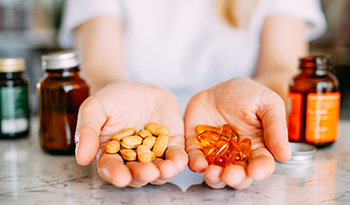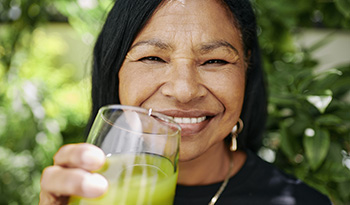צמחים טבעיים ובריאות קוגניטיבית

המגבלות של הטיפולים קונבנציונליים גורמות למחקרים על צמחים
שיטיון (דמנציה) היא מחלה ניוונית במוח שגורמת לליקויים שהולכים וגדלים בזיכרון וביכולת הלמידה, בתפקוד העצמאי ובפעילות היומיומית. יש יותר מ-47.5 מליון איש עם שיטיון ברחבי העולם, ו-7.7 מקרים חדשים מדי שנה. סיכון מוגבר לשיטיון וסקולרי מתקשר גם להשמנת יתר, לחץ דם גבוה, מחלות לב ואירועים מוחיים (כגון שבץ). שיטיון וסקולרי מהווה 10-15% מכל מקרי השיטיון במדינות מפותחות, ו-30% ממקרי השיטיון באיזורים פחות מפותחים בעולם. זהו סוג השיטיון השני הכי נפוץ בעולם, אחרי אלצהיימר. למעלה מ-40% מחולי שיטיון וסקולרי סובלים גם מאלצהיימר. שילוב זה הוא השיטיון המשולב הנפוץ ביותר.
תרופות כגון מעכבי כולינסטראז ונוגדי קולטני גלוטמאט מסייעים במקרי אלצהיימר מסוימים, אך בעלי השפעה נמוכה על שיטיון וסקולרי. התוצאה היא שחולי שיטיון וסקולרי רבים משתמשים בצמחים ובגישות משלימות וחלופיות כגון דיקור סיני, תוספי תזונה לשיפור הבריאות, יוגה, טיי צ'י וטיפול במוזיקה.
צמחים רבים המשמשים ברפואה סינית נחקרו בנפרד ובשילובים שונים כדי לבדוק את ההשפעה האפשרית שלהם לטיפול בתסמיני אלצהיימר ושיטיון וסקולרי. להלן רשימה חלקית שלהם: גינקו דו-אונתי, הופרזיה סראטה, כורכום, פנקס ג'ינסנג, פנקס נוטוג'ינסנג, פשטה שרועה, מרווה סינית, כרכום סתיו, and קמליה סינית. בהמשך המסמך תמצאו סקירה מהירה של מחקרים על צמחים סיניים יחידים ועל תרכובות מורכבות של צמחים סיניים שנבדקו בגלל הפוטנציאל שלהם לשפר את התפקוד הקוגניטיבי בקרב מבוגרים בריאים ובקרב חולי שיטיון.
לצמחים יחידים יש יתרונות, אבל הם מוגבלים
ממחקרים עדכניים עולה כי תמציות של גינקו דו-אונתי משפרות את הלמידה והזיכרון בקרב צורות של שיטיון וסקולרי שחיות לוקות בו. מחקרים גדולים עם קבוצת בקרה שקיבלה פלצבו וניתוחי-על של מחקרים העומדים בתנאים מדעיים מחמירים תומכים בטענה זו. תמצית של 400;">גינקו דו-אונתי מאטה את קצב ההדרדרות בתפקוד הקוגניטיבי, בתפקוד העצמאי ובהתנהגות בקרב אנשים שאובחנו כסובלים משיטיון וסקולרי ואלצהיימר. המכניזם שהוצע שבעזרתו גינקו דו-אונתי משפר את תפקוד המוח, מה שמוביל לשיפור בזיכרון ובתפקוד הקוגניטיבי, לרבות פעילות מופחתת של מקרופאגים המעודדים דלקות, שיפור בזרימת הדם, פעילות מופחתת של גורמים מפעילי טסיות דם (מה שמפחית את הסיכוי לקבל שבץ), ירידה בהפקת קורטיקוסטרואידים וספיגת גלוקוז מוגברת. כל אלו מגבירים את התרבות תאי הגזע העצביים, מאיצים את הפלסטיות של הסינפטות לאחר פגיעה מוחית, מפחיתים את רמת הכולסטרול החופשי שבדם ומפחיתים את הפקת החלבון המקדים עמילואיד בטא במוח.
כורכומה לונגה (כורכום) נמצא בשימוש מזה מאות שנים ברפואה הסינית, ההינדואית והאיור וודית עבור מספר בעיות בריאותיות לרבות דלקת הלבלב, דלקת פרקים, סרטן ומחלות דלקתיות, ניווניות ובמערכת העיכול. מחקרים על בעלי חיים ומחקרים חוץ-גופניים מראים שהיתרונות הקוגניטיביים של כורכום מבוססים על מספר פעולות שלו, ביניהן דיכוי החימצון החומצתי של ליפידים, טיהור סוגי חמצן ריאקטיבי וסוגי חנקן ריאקטיביים, דיכוי של הפעלת חלבון NF-kB והפעולות נוגדות הדלקתיות שלו. כורכום עשוי גם לחבר סוגים קטנים של בטא-עמילואיד כדי לחסום את ההצטברות וההיווצרות של הסתבכויות שמובילות לפרפור. במחקר קליני שערך 24 חודשים, 36 משתתפים הלוקים באלצהיימר ברמה נמוכה עד בינונית נטלו ברנדומליות כורכום (2 ו-4 גרם ביום) או פלצבו חוו הבדלים שאינם משמעותיים ברמת התפקוד הקוגניטיבי והזיכרון. הממצאים האלו עשויים להיות בין השאר בגלל הזמינות הביולוגית הנמוכה של הכורכום בו נעשה שימוש במחקר.
ממחקרים על בעלי חיים עולה כי רכיבים ביו-אקטיביים של פנקס ג'ינסנג עשויים לשפר את התפקוד הקוגניטיבי ואת הזיכרון בקרב מטופלים הסובלים משיטיון. הג'ינסנוסיד Rg5 מפחית את פעילות העמילואידים-ββ-את ההפחתה של פפטידי עמילואיד באמצעות הגברת ביטוי הגנים. פנקס ג'ינסנג עשוי גם להפחית את לחץ הדם ולשפר את זרימת הדם באמצעות הגברת תהליך התרחבות כלי הדם. משני ניסויים פתוחים בני 12 שבועות עולה כי ג'ינסנג עשוי לשפר את התפקוד הקוגניטיבי באנשים שאובחנו כחולי אלצהיימר. בשני ניסויים פתוחים קטנים, אנשים שאובחנו כחולים באלצהיימר שקיבלו פנקס ג'ינסנג במנות של 4.5 ו-9 גרם ביום, חוו שיפור ניכר בתפקוד הקוגניטיבי ובזיכרון. משני ניסויים קטנים עם קבוצת בקרה שקיבלה פלצבו עולה שפנקס נוטוג'ינסנג משפר את זרימת הדם במוח ומשפר את הזיכרון בקרב אנשים שאובחנו כחולים בשיטיון וסקולרי.
פשטה שרועה&מגנה על הנוירונים ונוגדת חימצון, ובנוסף היא פועלת כמסלק רדיקלים חופשיים ועשויה להגביר את זרימת הדם במוח. הצמח הזה משמש רבות ברפואה איור וודית לטיפול בבעיות זיכרון. מחקרים על היתרונות הקוגניטיביים של הצמח בקרב מבוגרים בריאים ואנשים הסובלים מאלצהיימר נערכים כעת.
זעפרן (כרכום סתיו) משמש ברפואה סינית כנוגד דיכאון, נוגד עיוותיות, ומפחית הפרשות. לתמציות המכילות קרוקין יש תכונות נוגדות חימצון ונוגדות טסיות ומחקרים הראו שהן משפרות את הלמידה והזיכרון במודלים של שיטיון בעלי חיים. בניסוי קליני עם סמיות כפולה ורנדומיזציה בן 22 שבועות על חולי אלצהיימר שקיבלו זעפרן במינון של 30 מ"ג ליום ואת מעכב הכולינאסטראז דונפזיל במיון של 10 מ"ג ליום הראו שיפור ברמות דומות בתפקוד הקוגניטיבי, בעוד הסבילות לזעפרן הייתה טובה יותר. בניסוי בסמיות כפולה בן 16 שבועות, חולי אלצהיימר שקיבלו זעפרן הגיבו בצורה טובה בהרבה מקבוצת הפלצבו.
תה (קמליה סינית) נצרכת על-ידי אנשים רבים לצורכי בריאות, מכילה אפיגלוקטצין-3-גלאט (EGCG), שמגן על נוירונים, יש לו השפעה אנטי-דלקתית, פועל כמסלק רדיקלים חופשיים, ועוד. לאנשים שמרבים לשתות תה יש סיכון מופחת לפתח אלצהיימר. שני מחקרים שנמצאים בעיצומם מראים שצריכה קבועה של תה ירוק בקרב בני הגיל השלישי קשורה לסיכון מופחת יחסית לחוות לקויות קוגניטיביות ושיטיון.
הממצאים ממחקרים על צמחים בודדים והשפעת על שיטיון הם מוגבלים בגלל גדלי מדגם קטנים של ניסויים קליניים יחידים, איכות מתודולוגית נמוכה ומשכי מחקר קצרים. בנוסף, ריכוזי פלזמה של רכיבים ביו-אקטיביים של צמחים בודדים רבים עשויים להיות נמוכים מכדי שתהיה להם השפעה חיובית, מה שמרמז על כך ששיפורים בתפקוד הקוגניטיבי עשויים להיות קשורים לאינטראקציה סינרגטית בין שני רכיבים ביו-אקטיביים או יותר. רפואה סינית ומערכות רפואה אסייתיות אחרות לעתים קרובות משלבות שילובים של צמחים, מה שעשוי להוביל לאינטראקציות סינרגטיות בין רכיבים ביו-אקטיביים שונים שעשויים לטפל במחלות שהגורמים להן מורכבים כמו אלצהיימר ושיטיון וסקולרי באופן יעיל יותר. לאחרונה נעשה שימוש בשיטת מחקר מקורית שנקראת ניתוח ממערכת למערכת על סוגיית האינטראקציות הסינרגטיות בפורמולות צמחיות.
הפוטנציאל של פורמולות צמחיות מורכבות
נערכו רק מספר מצומצם של מחקרים על תרכובות צמחים מורכבות והשפעתן על שיטיון וסקולרי. אמנם חלק מהם הגיעו לממצאים חיוביים, החשיבות של הממצאים מוגבלת בגלל גודל המחקרים ופגמים מתודולוגיים. מסקירה מערכתית של מחקרים על ההשפעה של תרכובות צמחים מורכבות על שיטיון וסקולרי מ-2012 עולה כי רוב התרכובות שנבחנו הובילו לשיפור משמעותי בהרבה בתפקוד הקוגניטיבי בהשוואה לתרופות קונבנציונליות ובהשוואה לפלצבו. בארבעה מחקרים במסגרתם תרופות צמחיות שולבו עם תרופות קונבנציונליות השיפור בתפקוד הקוגניטיבי היה גבוה יותר מכאשר תרופות קונבנציונליות ניתנו בנפרד, אך החשיבות של הממצאים הללו מוגבלת בגלל פגמים מתודולוגיים משמעותיים במחקרים. לאחרונה נערך ניתוח-על שכלל ניסויים קליניים עם רנדומיזציה (שכולם נערכו בסין) על אנשים שאובחנו כסובלים משיטיון וסקולרי. בניתוחי תת-קבוצות, התערבויות צמחיות סיניות הגבירו משמעותית את התפקוד הקוגניטיבי בהשוואה לפירסטאם (ב-10 מחקרים) או לפלצבו (ב-3 מחקרים). אנשים שקיבלו תרופות צמחיות חוו שיפור גדול יותר בפעילויות היומיומיות שלהם בהשוואה לאנשים שקיבלו פירסטאם. עם זאת, כמו במחקרים לעיל, החשיבות של הממצאים הללו מוגבלת בגלל פגמים מתודולוגיים.
מאמצים מתמשכים לפתח פורמולה צמחית מורכבת לשיטיון וסקולרי
גינקו דו-אונתי (גינקו), פנקס ג'ינסנג (ג'ינסנג), and וכרכום סתיו (זעפרן) .
המינון האופטימלי של רכיבים ביו-אקטיביים והמינון האופטימלי של SLT נקבעו באמצעות סדרת מחקרים על בעלי חיים. ניסויים קדם-קליניים הראו שיפור ניכר בלמידה ובזיכרון, שהם סממנים של פעילות נוירו-פתולוגית ונוגדת חימצוןבמודלים של שיטיון של בעלי חיים. בזמן כתיבת מאמר זה, מחקרים גדולים של שלב 3 יצאו לדרך כדי לאשש את האפקטיביות של התרופה על אנשים שאובחנו שחולי אלצהיימר. הממצאים הסיכומיים מניסויים קדם-קליניים הראו של-SLT יש מספר השפעות חיוביות על כלי הדם במוח, ביניהם איזורים מופחתים של פגיעה באספקת הדם או זילוח, הצטברות טסיות מופחתת ופעילות סילוק רדיקלים חופשיים מוגברת.
אנשים שקיבלו SLT או פלצבו סובלים מאותו הסיכון לסבול מתופעות לוואי שליליות. בניסוי מבוקר קטן עם רנדומיזציה, 16 מבוגרים בריאים שקיבלו SLT באופן רנדומלי חוו שיפור בזיכרון הפעיל שלהם. במחקר קטן בשלב 2, אנשים שאובחנו כמי שכנראה סובלים משיטיון וסקולרי שקיבלו SLT באופן רנדומלי הציגו שיפור גדול בהרבה בתפקוד הקוגניטיבי, וחלקם אף הראו זרימת דם מוגברת באיזורים במוח שקשורים לזיכרון ולעיבוד שמע ודיבור. מחקר שני בשלב 2 בן 12 חודשים על 325 אנשים שאובחנו כמי שכנראה סובלים משיטיון וסקולרי הראה שיפורים דומים בתפקוד הקוגניטיבי. באף אחד מהמחקרים בשלב השני לא עלה דיווח על השפעות שליליות שקשורות ל-SLT. בזמן כתיבת מאמר זה, ישנם שני ניסויים בשלב השלישי במספר מרכזים שמתבצעים כעת. בהינתן אישור על ממצאי שלב 3, SLT עשוי להפוך לטיפול צמחי המבוסס על הראיות בשיטיון וסקולרי, שהיא מחלה ניוונית שכרגע לא מוכר עבורה טיפול יעיל.
הפניות:
- Chang et al Herbal Medicine for theTreatment of Vascular Dementia: An Overview of Scientific Evidence 2016)
- Dementia Fact Sheet, World Health Organization, 2016.
- N. Kalaria, G. E. Maestre, R. Arizaga et al., “Alzheimer’s disease and vascular dementia in developing countries: prevalence, management, and risk factors,” The Lancet Neurology, vol. 7, no. 9, pp. 812–826, 2008.
- K. A. Nolan, M. M. Lino, A. W. Seligmann, and J. P. Blass, “Absence of vascular dementia in an autopsy series from a dementia clinic,” Journal of the American Geriatrics Society, vol. 46, no. 5, pp. 597–604, 1998.
- M. R. Farlow, M. L. Miller, and V. Pejovic, “Treatment options in Alzheimer’s disease: maximizing benefit, managing expectations,” Dementia and Geriatric Cognitive Disorders, vol. 25, no. 5, pp. 408–422, 2008.
- D. A. Levine and K. M. Langa, “Vascular cognitive impairment: disease mechanisms and therapeutic implications,”Neurotherapeutics, vol. 8, no. 3, pp. 361–373, 2011.
- H. Shim, “Vascular cognitive impairment and post-stroke cognitive deficits,” Current Neurology and Neuroscience Reports, vol. 14, no. 1, article 418, 2014.
- P. C. Chan, Q. Xia, and P. P. Fu, “Ginkgo biloba leave extract: biological, medicinal, and toxicological effects,” Journal of Environmental Science and Health. Part C, Environmental Carcinogenesis & Ecotoxicology Reviews, vol. 25, no. 3, pp. 211–244, 2007.
- J. Wang, W. Chen, and Y. Wang, “A ginkgo biloba extract promotes proliferation of endogenous neural stem cells in vascular dementia rats,” Neural Regeneration Research, vol. 8, no. 18, pp. 1655–1662, 2013.
- L.-Y. Zhang and Y.-L.Wang, “[Effects of EGb761 on hippocampal synaptic plasticity of vascular dementia rats],” Chinese journal of applied physiology, vol. 24, no. 1, pp. 36–40, 2008.
- Z.-X. Yao, Z. Han, K. Drieu, and V. Papadopoulos, “Ginkgo biloba extract (Egb 761) inhibits amyloid production by lowering free cholesterol levels,” Journal of Nutritional Biochemistry, vol. 15, no. 12, pp. 749–756, 2004.
- M. Hrehorovsk´a, J. Burda, I. Domor´akov´a, and E. Mech´ırov´a, “Effect of Tanakan on postischemic activity of protein synthesis machinery in the rat brain,” General Physiology and Biophysics, vol. 23, no. 4, pp. 457–465, 2004.
- P.-O. Koh, “Gingko biloba extract (EGb 761) prevents cerebral ischemia-induced p70S6 kinase and S6 phosphorylation,” American Journal of Chinese Medicine, vol. 38, no. 4, pp. 727–734, 2010.
- S. Saleem, H. Zhuang, S. Biswal, Y. Christen, and S. Dor´e, “Ginkgo biloba extract neuroprotective action is dependent on heme oxygenase 1 in ischemic reperfusion brain injury,” Stroke, vol. 39, no. 12, pp. 3389–3396, 2008.
- B. Spinnewyn, N. Blavet, and F. Clostre, “[Effects of ginkgo biloba extract on a cerebral ischemia model in gerbils],” Presse Medicale, vol. 15, no. 31, pp. 1511–1515, 1986.
- M.-N. Rocher, D. Carr´e, B. Spinnewyn et al., “Long-term treatment with standardized Ginkgo biloba Extract (EGb 761) attenuates cognitive deficits and hippocampal neuron loss in a gerbil model of vascular dementia,” Fitoterapia, vol. 82,no. 7, pp. 1075–1080, 2011.
- W.-Z. Li,W.-Y.Wu, H. Huang, Y.-Y.Wu, and Y.-Y. Yin, “Protective effect of bilobalide on learning and memory impairment in rats with vascular dementia,” Molecular Medicine Reports, vol. 8, no. 3, pp. 935–941, 2013.
- L. S. Schneider, “Ginkgo biloba extract and preventing Alzheimer disease,” JAMA, vol. 300, no. 19, pp.2306–2308,2008.
- R. Ihl, M. Tribanek, N. Bachinskaya, and Gotaday Study Group, “Efficacy and tolerability of a once daily formulation of Ginkgo biloba extract EGb 761(R) in Alzheimer’s disease and vascular dementia: results from a randomised controlled trial,” Pharmacopsychiatry, vol. 45, no. 2, pp. 41–46, 2012.
- S. Gauthier and S. Schlaefke, “Efficacy and tolerability of Ginkgo biloba extract EGb 761_ in dementia: a systematic review and meta-analysis of randomized placebo-controlled trials,” Clinical Interventions in Aging, vol. 9, pp. 2065–2077, 2014.
- M.-S. Tan, J.-T. Yu, C.-C. Tan et al., “Efficacy and adverse effects of Ginkgo Biloba for cognitive impairment and dementia: a systematic review and meta-analysis,” Journal of Alzheimer’s Disease, vol. 43, no. 2, pp. 589–603, 2015.
- Y. Wang, L.-Q. Huang, X.-C. Tang, and H.-Y. Zhang, “Retrospect and prospect of active principles from Chinese herbs in the treatment of dementia,” Acta Pharmacologica Sinica, vol. 31, no. 6, pp. 649–664, 2010.
- J. M. Ringman, S. A. Frautschy, G. M. Cole, D. L. Masterman, and J. L. Cummings, “A potential role of the curry spice curcumin in Alzheimer’s disease,” Current Alzheimer Research, vol. 2, no. 2, pp. 131–136, 2005.
- F. Yang, G. P. Lim, A. N. Begum et al., “Curcumin inhibits formation of amyloid oligomers and fibrils, binds plaques, and reduces amyloid in vivo,” The Journal of Biological Chemistry, vol. 280, no. 7, pp. 5892–5901, 2005.
- J. M. Ringman, S. A. Frautschy, E. Teng et al., “Oral curcumin for Alzheimer’s disease: tolerability and efficacy in a
- 24-week randomized, double blind, placebo-controlled study,” Alzheimer’s Research andTherapy, vol. 4, no. 5, article 43, 2012.
- S. Chu, J. Gu, L. Feng et al., “Ginsenoside Rg5 improves cognitive dysfunction and beta-amyloid deposition in STZ induced memory impaired rats via attenuating neuroinflammatory responses,” International Immunopharmacology, vol. 19,no. 2, pp. 317–326, 2014.
- H. Yang, J. Zhang, R. M. Breyer, and C. Chen, “Altered hippocampal long-term synaptic plasticity in mice deficient in the PGE2 EP2 receptor,” Journal of Neurochemistry, vol. 108, no. 1, pp. 295–304, 2009.
- J.-X. Liu, W.-H. Cong, L. Xu, and J.-N. Wang, “Effect of combination of extracts of ginseng and ginkgo biloba on acetylcholine in amyloid beta-protein-treated rats determined by an improved HPLC,” Acta Pharmacologica Sinica, vol. 25, no.9, pp. 1118–1123, 2004.
- J. Shi, S. Zhang, M. Tang et al., “The 1239G/C polymorphism in exon 5 of BACE1 gene may be associated with sporadic Alzheimer’s disease in Chinese Hans,” American Journal of Medical Genetics Part B: Neuropsychiatric Genetics, vol. 124, no. 1, pp. 54–57, 2004.
- Y. Sun, J. Ke, N. Ma, Z. Chen, C. Wang, and X. Cui, “[Effects of root rot on saponin content in Panax notoginseng],” Zhong yao cai = Zhongyaocai = Journal of Chinese medicinal materials, vol. 27, no. 2, pp. 79–80, 2004.
- K.-T. Choi, “Botanical characteristics, pharmacological effects and medicinal components of Korean Panax ginseng CA Meyer,” Acta Pharmacologica Sinica, vol. 29, no. 9, pp. 1109–1118, 2008.
- J.-H. Heo, S.-T. Lee, K. Chu et al., “An open-label trial of Korean red ginseng as an adjuvant treatment for cognitive impairment in patients with Alzheimer’s disease,” European Journal of Neurology, vol. 15, no. 8, pp. 865–868, 2008.
- S.-T. Lee, K. Chu, J.-Y. Sim, J.-H. Heo, and M. Kim, “Panax ginseng enhances cognitive performance in Alzheimer disease,” Alzheimer Disease and Associated Disorders, vol. 22, no. 3, pp. 222–226, 2008.
- J.-H. Heo, S.-T. Lee, M. J. Oh et al., “Improvement of cognitive deficit in Alzheimer’s disease patients by long term treatment with Korean red ginseng,” Journal of Ginseng Research, vol. 35, no. 4, pp. 457–461, 2011.
- J. Tian, “Ginseng may improve memory in stroke dementia patients,” in Proceedings of the American Stroke Association Meeting, Augusta, Canada, 2003.
- Q. F.Gui,Y.M.Yang, S. H. Ying, andM. M. Zhang, “Xueshuantong improves cerebral blood perfusion in elderly patients with lacunar infarction,” Neural Regeneration Research, vol. 8, no. 9, pp. 792–801, 2013.
- A. Russo and F. Borrelli, “Bacopamonniera, a reputed nootropic plant: an overview,” Phytomedicine, vol. 12, no. 4, pp. 305–317, 2005.
- S. K. Bhattacharya, A. Bhattacharya, A. Kumar, and S. Ghosal, “Antioxidant activity of Bacopa monniera in rat frontal cortex, striatum and hippocampus,” Phytotherapy Research, vol. 14, no. 3, pp. 174–179, 2000.
- A. Russo, A. A. Izzo, F. Borrelli, M. Renis, and A. Vanella, “Free radical scavenging capacity and protective effect of Bacopa monniera L. on DNA damage,” Phytotherapy Research, vol. 17, no. 8, pp. 870–875, 2003.
- N. Kamkaew, C. N. Scholfield, K. Ingkaninan, N. Taepavarapruk, and K. Chootip, “Bacopa monnieri increases cerebral blood flow in rat independent of blood pressure,” Phytotherapy Research, vol. 27, no. 1, pp. 135–138, 2013.
- C. Stough, A. Scholey, V. Cropley et al., “Examining the cognitive effects of a special extract of Bacopa monniera (CDRI08: Keenmind): a review of ten years of research at Swinburne University,” Journal of Pharmacy and Pharmaceutical Sciences, vol. 16, no. 2, pp. 254–258, 2013.
- C. K. Stough, M. P. Pase, V. Cropley et al., “A randomized controlled trial investigating the effect of Pycnogenol and Bacopa CDRI08 herbal medicines on cognitive, cardiovascular, and biochemical functioning in cognitively healthy elderly people: theAustralian ResearchCouncil Longevity Intervention (ARCLI) study protocol (ANZCTR12611000487910),” Nutrition Journal, vol. 11, article 11, 2012.
- K. Abe and H. Saito, “Effects of saffron extract and its constituent crocin on learning behaviour and long-term potentiation,” Phytotherapy Research, vol. 14, no. 3, pp. 149–152, 2000. H. Hosseinzadeh and T. Ziaei, “Effects of Crocus sativus stigma extract and its constituents, crocin and safranal, on intact memory and scopolamine−induced learning deficits in rats performing the Morris water maze task,” Journal of Medicinal Plants, vol. 5, no. 19, pp. 40–50, 2006.
- H. Hosseinzadeh and H. R. Sadeghnia, “Safranal, a constituent of Crocus sativus (saffron), attenuated cerebral ischemia induced oxidative damage in rat hippocampus,” Journal of Pharmacy and Pharmaceutical Sciences, vol. 8, no. 3, pp.394–399, 2005.
- S. W. Jessie and T. P. Krishnakantha, “Inhibition of human platelet aggregation and membrane lipid peroxidation by food spice, saffron,”Molecular and Cellular Biochemistry, vol. 278, no. 1, pp. 59–63, 2005.
- S. Akhondzadeh, M. S. Sabet, M. H. Harirchian et al., “A 22-week, multicenter, randomized, double-blind controlled trial of Crocus sativus in the treatment of mild-to-moderate Alzheimer’s disease,” Psychopharmacology, vol. 207, no.4, pp.637–643, 2010.
- S. Akhondzadeh, M. S. Sabet, M. H. Harirchian et al., “Saffron in the treatment of patients with mild to moderate Alzheimer’s disease: a 16-week, randomized and placebo-controlled trial,” Journal of Clinical Pharmacy andTherapeutics, vol. 35, no. 5, pp. 581–588, 2010.
- S. A. Mandel, T. Amit, L. Kalfon, L. Reznichenko, and M. B. H. Youdim, “Targeting multiple neurodegenerative diseases etiologies with multimodal-acting green tea catechins,” Journal of Nutrition, vol. 138, no. 8, pp. 1578S–1583S, 2008.
- A. B. Sharangi, “Medicinal and therapeutic potentialities of tea (Camellia sinensis L.)—a review,” Food Research International, vol. 42, no. 5-6, pp. 529–535, 2009.
- M. Noguchi-Shinohara, S. Yuki, C. Dohmoto et al., “Consumption of green tea, but not black tea or coffee, is associated with reduced risk of cognitive decline,” PLoS ONE, vol. 9, no. 5, Article ID e96013, 2014.
- H. Wagner and G. Ulrich-Merzenich, “Synergy research: approaching a new generation of phytopharmaceuticals,” Phytomedicine, vol. 16, no. 2-3, pp. 97–110, 2009.
- X. Zhou, S. W. Seto, D. Chang et al., “Synergistic effects of Chinese herbal medicine: a comprehensive review of methodology and current research,” Frontiers in Pharmacology, vol. 7, article 201, 2016.
- K. Iwasaki, S. Kobayashi, Y. Chimura et al., “A randomized, double-blind, placebo-controlled clinical trial of the Chinese herbal medicine ‘Ba Wei Di Huang Wan’ in the treatment of dementia,” Journal of the American Geriatrics Society, vol. 52, no. 9, pp. 1518–1521, 2004.
- K. Nagata, E. Yokoyama, T. Yamazaki et al., “Effects of yokukansan on behavioral and psychological symptoms of vascular dementia: an open-label trial,” Phytomedicine, vol. 19, no. 6, pp. 524–528, 2012.
- S. C. Man, K. W. Chan, J. Lu, S. S. Durairajan, L. Liu, and M. Li, “Systematic review on the efficacy and safety of herbal medicines for vascular dementia,” Evidence-Based Complementary and Alternative Medicine, vol. 2012, Article ID 426215, 22 pages, 2012.
- D. Gong, J. Xu, and Y. Fan, “Meta-analysis of clinical trials of oral Chinese herbal prescriptions for treatment of vascular dementia based on mini mental state examination scores,” European Journal of Integrative Medicine, vol. 7, no. 2, pp. 108–117, 2015.
- L. Xu, W. Cong, C. Wei, and J. Liu, “Effects of Weinaokang (SLT) on dysmnesia in micemodels,” Pharmacology and Clinics of Chinese Materia Medica, no. 6, pp. 60–62, 2007.
- L. Xu, J.-X. Liu, W.-H. Cong, and C.-E. Wei, “[Effects of Weinaokang capsule on intracephalic cholinergic system and capability of scavenging free radicas in chronic cerebral hypoperfusion rats],” Zhongguo Zhongyao Zazhi, vol. 33, no.5, pp. 531–534, 2008.
- W. H. Cong, J. X. Liu, and L. Xu, “Effects of extracts of Ginseng and Ginkgo biloba on hippocampal acetylcholine and monoamines in PDAP-pV717I transgenic mice,” Zhongguo Zhong xi yi jie he za zhi Zhongguo Zhongxiyi jiehe zazhi, vol. 27, no. 9, pp. 810–813, 2007.
- W.-H. Cong, B. Yang, L. Xu et al., “Herbal extracts combination (WNK) prevents decline in spatial learning and memory in APP/PS1 mice through improvement of hippocampal A plaque formation, histopathology, and ultrastructure,” Evidence-based Complementary and Alternative Medicine, vol. 2012, Article ID478190, 9 pages, 2012.
- S. Seto, A. Jenkins, H. Kiat, A. Bensoussan, J. Liu, and D. Chang, “Protective effects of a standardised herbal formulation,
- Sailotong, on hydrogen peroxide (H2O2) induced damage in EA.HY926 Cells,” The Journal of Alternative and Complementary Medicine, vol. 22, no. 6, p. A35, 2016.
- T. Li, H.-M. Liu, Y. Lu et al., “Aphase I tolerance and safety study of Sailuotong capsule,” Chinese Journal of NewDrugs, vol. 21,no. 1, pp. 62–67, 2012.
- G. Z. Steiner, A. Yeung, J.-X. Liu et al., “The effect of Sailuotong (SLT) on neurocognitive and cardiovascular function in healthy adults: a randomised, double-blind, placebo controlled crossover pilot trial,” BMC Complementary and
- Alternative Medicine, vol. 16, no. 15, 2016. J. Liu, D. Chang, D. Chan, J. Liu, and A. Bensoussan, “A randomised placebo-controlled clinical trial of a Chinese herbal medicine for the treatment of vascular dementia,” in Proceedings of the 2nd International Congress for Complementary Medicine Research, Munich, Germany, 2007.
- D. Chang, B. Colagiuri, and R. Luo, Chinese Medicine used to Treat Dementia, Advances in Natural Medicines, Nutraceuticals and Neurocognition, CRC Press, 2013.
כתב ויתור: מרכז הבריאות הזה לא נועד לאבחן,,,













































































 תוכן העניינים
תוכן העניינים















